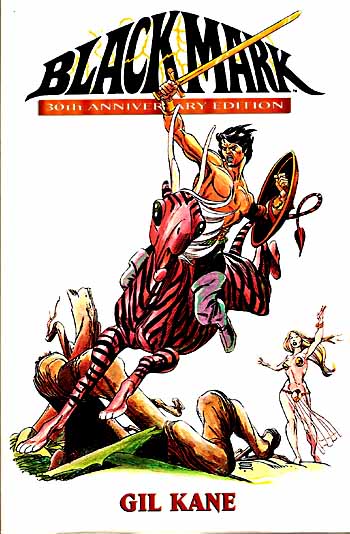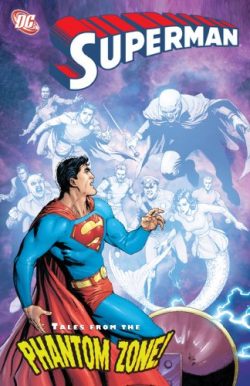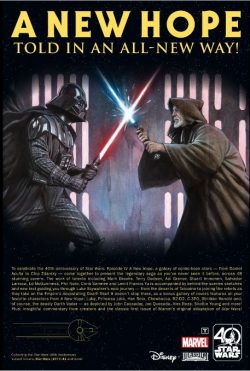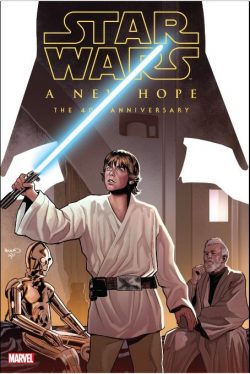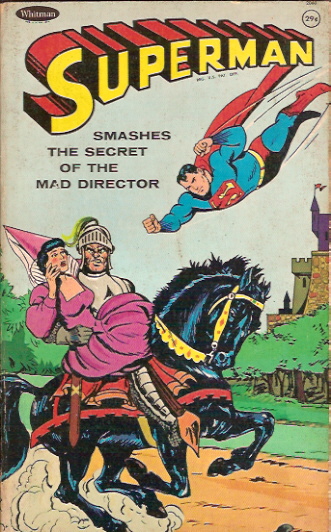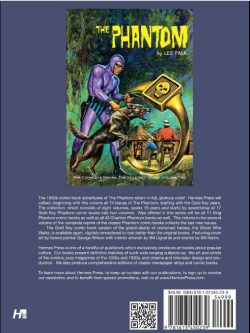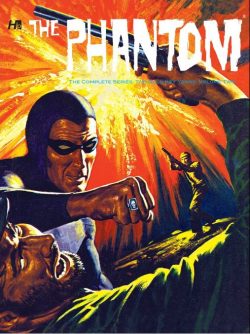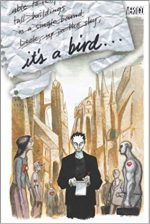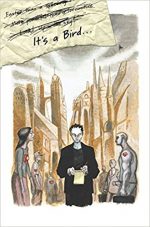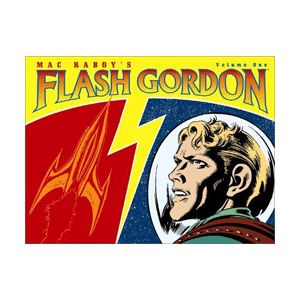
By Don Moore & Mac Raboy (Dark Horse)
ISBN: 978-1-56971-882-7
By most lights Flash Gordon is the most influential comic strip in the world. When the hero debuted on Sunday January 7th 1934 (with the superb Jungle Jim running as a supplementary “topper†strip) as an answer to the revolutionary, inspirational, but quirkily clunky Buck Rogers by Philip Nolan and Dick Calkins (which also began on January 7th, but in 1929) two new elements were added to the wonderment; Classical Lyricism and poetic dynamism. It became a weekly invitation to stunning exotic glamour and astonishing beauty.
Where Rogers blended traditional adventure and high science concepts, Flash Gordon reinterpreted fairy tales, heroic epics and mythology, spectacularly draping them in the trappings of the contemporary future, with varying ‘Rays’, ‘Engines’ and ‘Motors’ substituting for trusty swords and lances – although there were also plenty of those – and exotic craft and contraptions standing in for galleons, chariots and magic carpets. It was a narrative trick that kept the far-fetched satisfactorily familiar – and was continued by Raboy and Moore in their run. Look closely and you’ll see cowboys, gangsters and of course, flying saucer fetishes adding contemporary flourish to the fanciful fables in this volume…
Most important of all, the sheer artistic talent of Raymond, his compositional skills, fine line-work, eye for unmuddled detail and just plain genius for drawing beautiful people and things, swiftly made this the strip that all young artists swiped from.
When all-original comic books began a few years later, literally dozens of talented kids used the clean-lined Romanticism of Gordon as their model and ticket to future success in the field of adventure strips. Almost all the others went with Milton Caniff’s expressionistic masterpiece Terry and the Pirates (and to see one of his better disciples check out Beyond Mars, illustrated by the wonderful Lee Elias).
Flash Gordon began on present-day Earth (which was 1934, remember?) with a rogue planet about to smash the World. As global panic ensued, polo player Flash and fellow passenger Dale Arden narrowly escaped disaster when a meteor fragment downed their airliner. They landed on the estate of tormented genius Dr. Hans Zarkov, who imprisoned them in the rocket-ship he had built.
His plan? To fly the ship directly at the astral invader and deflect it from Earth by crashing into it…!
Thus began a decade of sheer escapist magic in a Ruritanian Neverland: a blend of Camelot, Oz and every fabled paradise that promised paradise yet concealed hidden vipers, ogres and demons, all cloaked in a glimmering sheen of sleek futurism. Worthy adversaries such as utterly evil but magnetic Ming, emperor of the fantastic wandering planet; myriad exotic races and shattering conflicts offered a fantastic alternative to drab and dangerous reality for millions of avid readers around the world.
Alex Raymond’s ‘On the Planet Mongo’ with Don Moore doing the bulk of the scripting, ran every Sunday until 1944, when the artist joined the Marines. On his return he eschewed wild imaginings for sober reality and created the gentleman detective serial Rip Kirby. The continuous, unmissable weekly appointment with sheer wonderment, continued under the artistic auspices of Austin Briggs – who had drawn the daily black and white instalments since 1940.
In 1948, eight years after beginning his career drawing for the Harry A. Chesler production “shop†comicbook artist Emanual “Mac†Raboy took over the illustration of the Sunday page. Moore remained as scripter and began co-writing with the artist.
Raboy’s sleek, fine-line brush style, heavily influenced by his idol Raymond, had made his work on Captain Marvel Jr., Kid Eternity and the especially Green Lama a benchmark of artistic quality in the proliferating superhero genre. His seemingly inevitable assumption of the extraordinary exploits led to a renaissance of the strip and in the rapidly evolving post-war world Flash Gordon became once more a benchmark of timeless, escapist quality that only Hal Foster’s Prince Valiant could touch.
This first 260 page volume, produced in landscape format and printed in bold stark monochrome (although one or two strips appear to have been scanned from printed colour copies) covers the period January 8th 1948 to May 10th 1953 and opens with Flash as President of Mongo when Slyk, a refugee from the believed-uninhabited moon of Lunita, arrives. Beseeching assistance to liberate his world from the tyrannical depredations of the wicked siblings Rudo and Lura, the Lunite accompanies Flash, Dale Arden and Dr. Zarkov to his hidden moon where the heroes are soon captured before Slyk saves the day.
This short transitional tale set up an unfailingly popular formula of nightmarish beasts, distressed damsels and outrageous adventure that would last until Raboy’s death in 1967.
Returning to Mongo Flash and Co. discovered a red comet hurtling towards that fabulous world. Whilst trying to deflect it they become trapped by the civilisation who inhabit its interior, creatures to whom gravity is but a toy… Once more romance, intrigue and beautifully depicted action were the order of many days until the trio toppled the masters and placed far more agreeable rulers in charge, saving their adopted world and the greater universe.
The saga lasted until June of 1949 and was promptly followed by a stunning undersea odyssey as a brief trip to Mongo’s beaches led Flash and Dale into murky waters when they rescued captivating Merma from monstrous sub-sea marauder Sharki and became enmeshed in a watery range-war and tricky romantic quadrangle involving hidden kingdoms, scaly savages and outrageous leviathans and sea-beasts.
It was off to the frozen principality of Polaria next where ambitious Prince Polon was covering up a plague of giant monsters preying on the people. Of course the scurvy villain was behind the plot, using size-shifting rays and his ultimate aim was to become dictator of all Mongo…
The scheme obviously gave other regional rulers ideas. No sooner did President Flash return than he was off again to the Tropix Islands where “Queen†Rubia had fomented rebellion and seceded from the democratic federation of Mongo States. Hands-on Flash went undercover with Dale in an Arabian adventure to rival Sinbad’s greatest: before the people were liberated and the despots destroyed there was a panoply of spectacular action and fantastic creatures to survive…
Rubia, defeated, was dispatched to the prison moon Exilia, but all was not right on that grim penal colony. Once more surreptitiously investigating our hero discovered that villains had taken over the penal-planet and were preparing to attack civilized Mongo. Luckily Rubia and criminal mastermind Zin believed Flash to be his own double, dispatched to Exilia for impersonating the President – but they’re were not fooled for long…
This awesome extended epic ran from 6th March to November 5th 1950 and was followed by a proposed change-of-pace as Flash and Dale took off for a much-needed vacation on Earth. Unfortunately ever-malicious Rubia sabotaged their ship and they crash-landed on the unexplored Planet Zeta. It surely came as no surprise to fans when they discovered another beautifully barbarous lost civilisation there…
Zeta was a world of colossal plants and feudal warriors, but hid a dangerous secret. Something in the environment consumed metal. Within minutes Flash and Dale saw their ship and weapons melt away… Befriended instead of attacked the castaways found the inhabitants lived on a world seemingly immune to technological advancement, controlled by “wizards†who soon decided that Flash was a threat…
Flash discovers the metal-eating plague was artificial and helped the Zetans rebel and they helped him construct a new ship. Once more en route for Earth Flash and Dale encountered a stranger meteor, but without further mishap arrived safely. On March 25th 1951 (17 years and some months after they departed) two of earth’s first star-travellers finally returned to their birthworld and were feted like royalty. Sadly they should have paid closer attention to that vagrant space-rock as soon, Earth was under attack by strategically aimed meteors.
With Einsteinish Professor Brite in tow, Flash and Dale tracked the attacks to the Moon where they met beetle-men and human dictator Rak who planned to conquer Earth with his lunar meteor gun. He had never encountered a man like Flash Gordon before…
With Rak’s threat ended Flash helped Earth build a sentinel Space Platform, but when he, Dale, engineer Dr. Ruff and his annoying niece Ginger began work 1000 miles up they clashed with a strange race of flying saucer-riding space gnomes from Mars…
At this time Mars clearly preferred, if not actually needed, Earth women and with Dale and Ginger abducted, another sterling romp ensued. Flash outfoxed the malign gnome-king Toxo before subsequently leading a full expedition to the Red planet where he discovered another advanced feudal civilisation and that Martian women – or at least their Queen, Menta – had no worries, looks-wise…
Menta was however, a spoiled and murderous psychopath determined to conquer Earth…
This epic ran until February 24th 1952, whereupon Flash returned to Earth to discover his homeworld gripped in a new Ice Age. Jetting to the Arctic the good guys found Frost Giants from Saturn (the fifth moon Rhea to be exact) and that the big Freeze was artificially induced. Although he destroyed their forward base the Giants dragged Flash back to Rhea and inadvertently introduced human smallpox into their population…
Earth commander “Icy†Stark abandoned Dale after a space battle but Flash, with new Rhean allies rescued her and once more led a hostage society to overthrow its unfit rulers. On the return to Earth the fleet encountered a guided comet and met a new foe in Pyron the Comet Master.
Reunited with Dr. Zarkov the heroes battled the demented scientist’s horrendous creatures, saving Earth from flaming doom but were catapulted helplessly to the surface of enigmatic Venus for the last complete adventure in this stellar collection.
Not only is our solar system teeming with unsuspected life, but it appeared most of it was ruled by complete sods, as Flash, Dale and Zarkov battled winged tree-men, swamp horrors and the nefarious overlord Stang, enduring staggering hardship and hazard before crushing the tyrant and freeing two separate races from terror.
With a new ship, the far-flung travellers set off for Earth but were forced to land on the Moon where a secret human base had been established. For unknown reasons Dr. Stella and her thuggish aide Marc detained and delayed them, but when an increasing number of close shaves and mysterious accidents occurred, a little digging revealed that they were the unwitting guests of ruthless space pirates…
As is probably fitting for one of the world’s greatest continuity strips this first volume ends on a gripping cliffhanger, but with so much incredible action, drawn with such magnificent style there’s no way any fan of classic adventure can possibly feel short-changed
Mac Raboy was the last of the Golden Age of romanticist illustrators, but his lush and lavish flowing adoration of the perfected human form was already fading from popular taste. The Daily feature at this time had already switched to the solid, chunky, He-manly, burly realism of Dan Barry and even Frank Frazetta. Here, however, at least the last outpost of beautiful elegant heroism and gracefully pretty perils prevail, thanks to these Dark Horse volumes which you can visit just as often as Flash and Dale popped between planets…
© 2003 King Features Syndicate Inc. ™ Hearst Holdings, Inc. All Rights Reserved.
